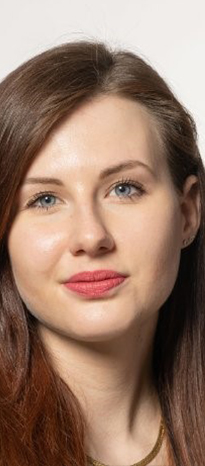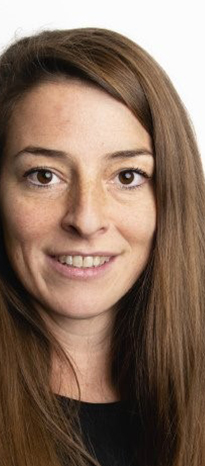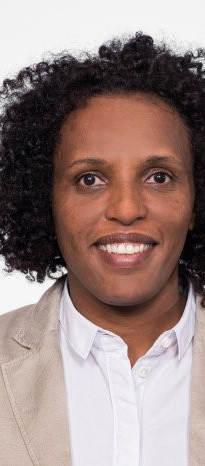✨ Happy Holidays! The E³UDRES² Team is available for your requests again from 07 January 2026.
ContactE³UDRES²
I Living Labs
Educational Entrepreneurs give insights into their experiences
Within the framework of the European University E³UDRES², the second round of I Living Labs (ILLs) took place in spring 2022. The St. Pölten UAS team thus spoke with the people who are actively involved – the Educational Entrepreneurs (EEs). At St. Pölten UAS, there was a total of eight Educational Entrepreneurs at that moment. Four of them took part in our Q&A session and provided insights into their role as Educational Entrepreneurs.

Maila Hemetek
Lecturer and researcher in the study programme Dietetics. With her training in communication studies, dietetics, and public health, she complements Mariella Seel's spectrum for the challenge they are jointly supervising this semester.

Janja Dörsch
lecturer at the Department of Media and Digital Technologies and a self-employed coach, trainer and presenter. She contributed her know-how to the challenge “Student participation in E³UDRES²”.

Hirut Grossberger
Hirut is a senior researcher at the Carl Ritter von Ghega Institute for Integrated Mobility Research and teaches at the Department of Rail Technology and Mobility.

What motivated you to get involved in the E³UDRES² project as an Educational Entrepreneur?
Mariella: What convinced me was the opportunity to experience an innovative teaching/learning format or rather an innovative method such as design thinking in “action” and to help shape it myself. The ILLs offer students the possibility to give this design process a try in a protected setting, and as an EE I can contribute my knowledge and experience and accompany the students' development process.
Hirut: I am generally very interested in international and interdisciplinary cooperation. I have been involved in the iLab programme of the St. Pölten UAS as a coach since its very beginning, which allowed me to gain important and striking experiences. The invitation to contribute to the E³UDRES² project was a chance to broaden my experience and to work with students from different partner universities and coaches of different professional fields. Therefore, it was with great pleasure that I applied.
Maila: I can only agree with Hirut and Mariella! Both aspects – the interdisciplinary, international cooperation as well as trying out a teaching method that was new to me – made me decide to work on the project. It was a leap into the unknown! But what gave me security was that as EEs, we never work alone but as a team. I always find co-teaching with other teachers – especially from other professions and countries – very enriching for my personal development as a teacher. As a dietician and lecturer in the Dietetics programme, I already have experience in interprofessional and international collaboration in teaching, but the framework that the ILLs provide for co-teaching and interaction with students is definitely special!
Janja: Personally, I enjoy breaking new ground and learning along the way. I also find the idea of co-creation and networking with other universities very exciting.
In your opinion, what is special about the I Living Labs?
Janja: In contrast to my other courses, we work with small groups of students in the ILLs. As EEs, we are also not alone in an ILL but we teach in pairs, sometimes even in threes when new colleagues accompany us. This enables us to exchange ideas with each other. In addition, we have regular meetings in which we discuss organisational and content-related topics that affect all ILLs and we also use those to share our experiences.
Maila: This closeness that you mention, Janja, that we as teachers can build with the students, is really something special. Until now, I have had small groups with a maximum of 6 students in my ILLs and we were always three coaches. That's a teacher-to-student ratio that you don't really have otherwise, and something I think is very nice. In this project, we have the opportunity to work very closely with the students and the other coaches – despite the long physical distance – and to really get to know the students individually.
Mariella: In addition to personal development, it is also extremely valuable for students to experience the development of products that are actually tailored to the needs of the users. In the area of digital healthcare, this approach should already be state of the art, yet it is unfortunately often neglected. The approach of the ILLs is therefore very different from “standard” courses, where students are usually presented with finished or almost-ready products, but how a product was made including the considerations along the way hardly play a role.
Hirut: As Mariella has just pointed out, this future-oriented development process is really something special. On the one hand, the ILLs enable students to deal with socially relevant challenges and to find innovations and solutions based on the design thinking process. On the other hand, they also develop future skills through the learning process they experience. The ILLs are characterised by finding interdisciplinary solutions and learning from each other as well as by intercultural communication, open discussions, and individual development goals based on future skills.
Janja: The students choose the future skills that you have mentioned by themselves and set them as their personal goal. The reflection of this progress, by means of a portfolio, forms the basis of their grade and the students are jointly graded in a final discussion, something that really differs from “standard teaching”.
Maila: The described setting in the ILLs enables us to accompany the students in their development process. Since the development goals are chosen by the students themselves and they also work very independently, the ILLs really give them the chance to reflect on themselves and the way they design their work processes. Of course, they also receive very comprehensive feedback from us. As a teacher, I also have the opportunity to reflect on the teaching content, the group dynamics, and our intervention in the group processes with the other coaches, which supports me in accompanying the students. It really would be nice to have more teaching formats like this.
Mariella: What I also experience as special is the way digital teaching is implemented in the ILLs. Our students come from all 6 partner universities – that's why the ILLs take place online and are accompanied by video conferences, but there is a lively exchange and participation with the students. Apart from the input phases, the students organise their own online meetings to work on their product. So, we are far away from the traditional lecture style that is often associated with digital formats.
How do you experience working with students from different countries and with different professional backgrounds?
Mariella: I think it is challenging, because – especially in regards to healthcare issues – it is important to find and create a shared knowledge base. Also, the health systems in the respective countries often differ a little, which is why everyone has different experiences and approaches to problems. On the other hand, the different backgrounds are the greatest asset – they lead to perspectives for the product that would not come to mind without the interdisciplinary and interprofessional approach.
Maila: As Mariella says, it can be quite a challenge. I think it is very important to support the individual students in becoming a group or a team. I have the feeling that there is no magic formula, but that you have to take a good look at the students and see what they need. In any case, this takes a lot of time. Many students are not used to this type of course where they have to actively participate and, above all, meet and work together as a group outside of the shared appointments. Because in the end, it is not about the professional background and not even about the developed product, but about how the students got there and the contribution of each individual, no matter how it is designed – which can also take a lot of pressure off the students.
Hirut: I find it very enriching to work with the students and coaches from partner universities from different countries and different professional backgrounds. It gives me joy to see how the students cooperate. Sometimes there are students who are more reserved in the beginning and it takes them some time to figure out how they can directly contribute their expertise to finding solutions. I try to motivate them and give them examples of how they can actively contribute.
Janja: Apart from the aspects already mentioned, it really does not make that much of a difference –the individual students are always very different. However, since we are working with students from 6 universities with very different fields of study, who are at different stages in their studies, the illusion of homogeneity does not arise in the first place. Still, we like to put the focus on the similarities – the common ground – which is an advantage, especially in the current situation.
Which highlight do you remember most fondly?
Maila: There are honestly so many, I don't even know where to start :-) What I enjoy most is when I see how the students grow together into a team and develop something together. When I witness how even the quiet and reserved students find their role in the team and can contribute their strengths – that makes me very happy. The students can experience themselves in a new way!
Janja: I feel the same way. One student and his personal development have stayed in my memory during the ILL: We had a student in the last round who was rather quiet and reserved at the beginning. However, he noticed that his colleagues (there were only young male students in the group) kept coming up to him. He had never wanted to take on a leadership role, but in the final interview he thanked them for the opportunity to discover his leadership skills in the ILL. In the ILL, it was not his technical expertise that was in demand, but his leadership skills, and he was very grateful for this valuable experience that broadened his personal horizon.
Hirut: From the first ILL, I particularly like to think about the show-down, where all ILLs presented their results and talked about their experiences during the discussions. At the ILL of the current semester, it was the day when we also invited the involved stakeholders to our meeting with the students. The students received feedback directly from them and the discussion was very exciting and enriching for the next step of the design thinking process, namely the further development of the prototype.
Mariella: My favourite moment was when the students started putting their ideas on paper and discussing them. When you could see that a thinking process was set in motion. I think that was the moment when the theoretical construct of design thinking suddenly took shape for the students, and they realised that they could now develop something themselves that might solve challenges for many people in the future.
Thank you for the interesting interview and the lively insights you gave us into your work as Educational Entrepreneurs!
Did this interview spark your interest? Would you also like to take initiative and responsibility for interdisciplinary, project-based learning together with colleagues and students from the E³UDRES² European University partners? The I Living Lab team is always looking for new colleagues to join! For each Educational Entrepreneur, 4 hours per person and week are calculated for the first phase of E³UDRES² until the end of June 2023. We appreciate your interest and look forward to receiving your e-mail to Christina Tanzer.
